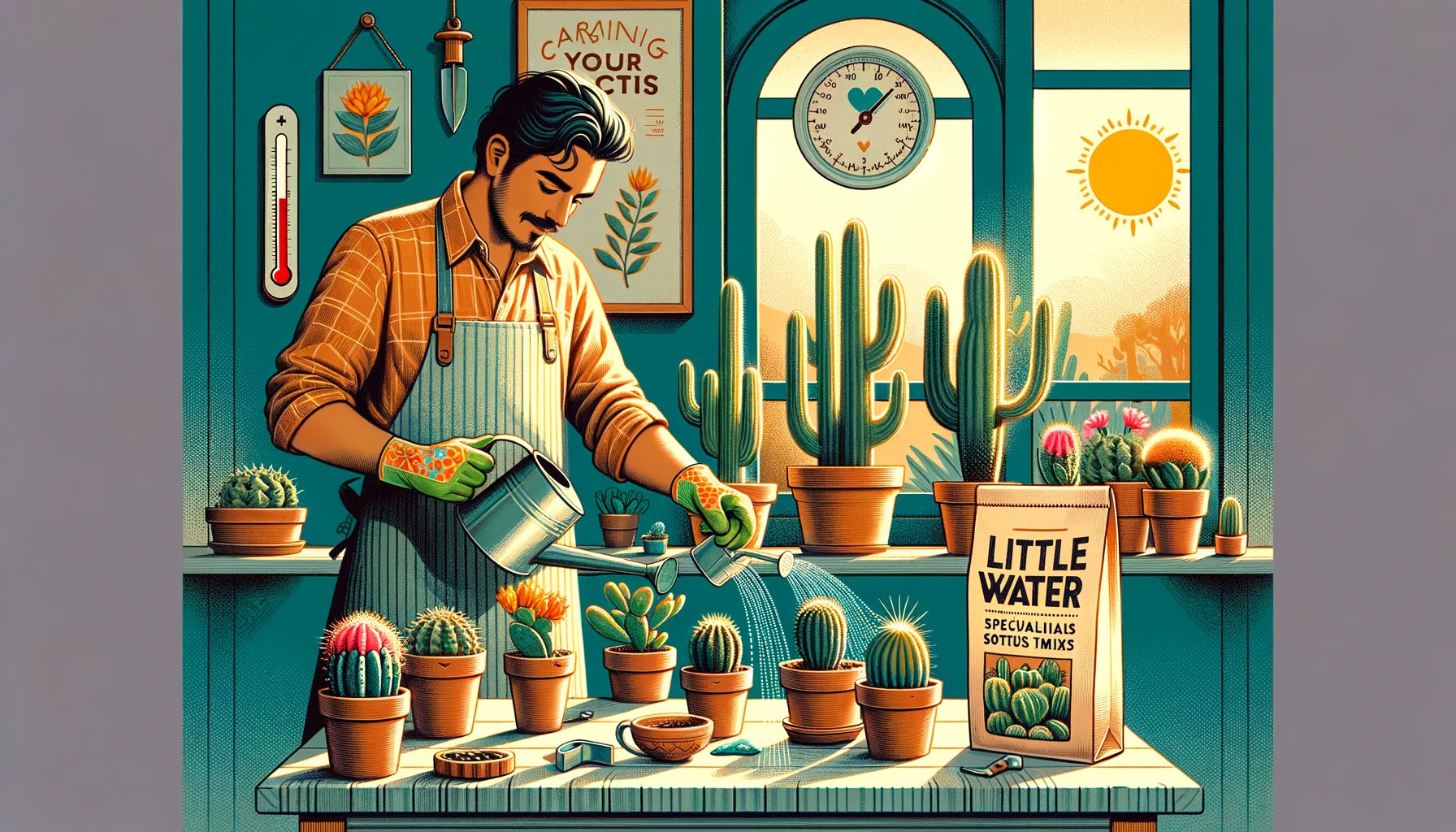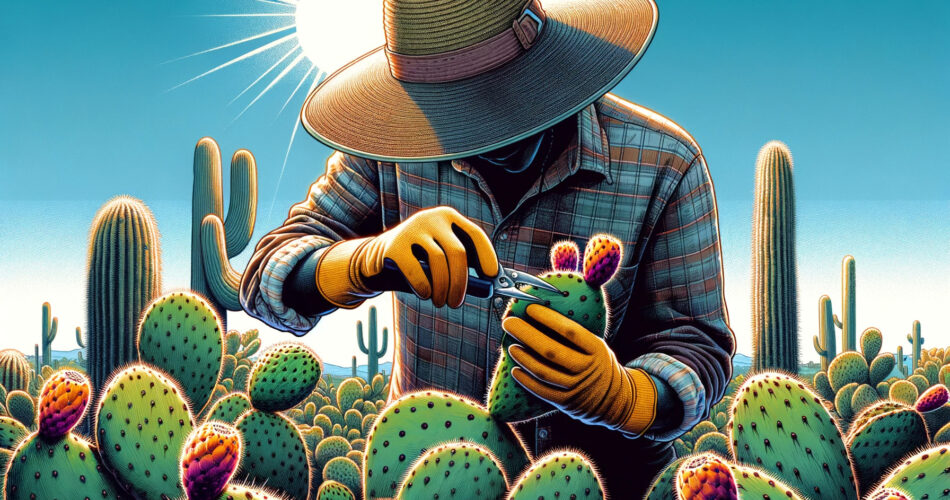Key Takeaways:
- Cacti, including prickly pear paddle plants, have unique adaptations that allow them to survive in harsh desert environments.
- There are over 2,000 known species of cacti, each with its own characteristics and growth habits.
- Caring for cacti involves understanding their watering needs, providing adequate sunlight, and using the right soil mix.
- Prickly pear paddles are nutritious and can be used in various culinary creations.
- Harvesting prickly pear paddles requires proper precautions to avoid getting injured by the cactus spines.
- Cacti should be collected and conserved ethically to protect their habitats and preserve their populations.
- Proper etiquette should be followed when visiting cactus gardens and reserves.
- Safe interaction with cacti in nature and home gardens requires caution and respect.
1. The Fascinating World of Cacti: A Closer Look at Prickly Pear Paddle Plants
Cacti, with their unique appearance and ability to thrive in harsh desert environments, have fascinated people for centuries. Prickly pear paddle plants, also known as Opuntia, are one of the most recognizable types of cacti. In this section, we will explore the history and origins of cacti, the different types of cacti and their characteristics, and the unique adaptations that allow cacti to survive in their natural environment.

1.1 The History and Origins of Cacti
The history of cacti dates back millions of years. They are believed to have originated in the Americas, with the majority of cacti species found in North and South America. The earliest known cacti fossils are from the late Cretaceous period, around 65 million years ago. Over time, cacti have adapted to survive in various climates and have spread to other parts of the world through natural dispersal and human cultivation.
To delve deeper into the history and origins of cacti, you can explore resources such as the Denver Botanic Gardens and the Arizona-Sonora Desert Museum.
1.2 The Different Types of Cacti and Their Characteristics
There are over 2,000 known species of cacti, each with its own unique characteristics and appearance. Cacti are classified into several categories based on their growth habits, such as columnar, globose, and trailing. Some well-known cacti species include the Saguaro (Carnegiea gigantea), Barrel (Ferocactus), and Christmas Cactus (Schlumbergera).
If you want to explore the diversity of cacti and gain a deeper understanding of their characteristics, the Cactus-Art website offers a comprehensive dictionary with detailed information on various cacti species.
1.3 The Unique Adaptations of Cacti in Their Natural Environment
Cacti have evolved several unique adaptations to survive in their arid and often hostile natural environment. One of the most notable adaptations is their ability to store water in their thick stems or pads. This allows them to withstand long periods of drought. Cacti also have modified leaves called spines, which help reduce water loss and protect the plant from herbivores.
If you want to delve deeper into the fascinating adaptations of cacti, you can explore resources such as the Encyclopedia Britannica and the ScienceDaily article on the subject.
2. Caring for Your Cacti: Essential Tips and Techniques
Proper care is crucial for the health and vitality of your cacti. In this section, we will explore essential tips and techniques for watering your cacti, providing adequate sunlight and optimal growing conditions, as well as potting, repotting, and soil requirements for cacti.

2.1 Understanding the Watering Needs of Cacti
Proper watering is critical for the well-being of cacti. Overwatering can lead to root rot, while underwatering can cause dehydration and poor growth. Cacti have unique water requirements due to their ability to store water. They prefer a period of dryness between waterings to mimic their natural habitat.
To determine the watering needs of your specific cactus species, it is essential to research the specific requirements of each type. However, a general rule of thumb is to water cacti thoroughly and then allow the soil to dry out completely before watering again.
For a more detailed guide on watering cacti, you can refer to resources such as the Cactus Plaza website and the Succulents and Sunshine blog.
2.2 Providing Adequate Sunlight and Optimal Growing Conditions
Cacti thrive in bright sunlight and require several hours of direct sunlight per day to grow and flower properly. However, intense heat and prolonged exposure to direct sunlight can cause sunburn or scorching. It is essential to find the right balance and monitor your cacti’s exposure to sunlight.
Furthermore, optimal growing conditions, such as suitable temperature ranges and proper ventilation, play a vital role in the overall health and growth of cacti. Some cacti species may require specific temperature conditions to thrive, so it is important to research the needs of the particular species you are caring for.
For a comprehensive guide on providing adequate sunlight and optimal growing conditions for cacti, you can explore resources such as the The Spruce website and the book “Cacti and Succulents for the Amateur” by W. R. Philip.
2.3 Potting, Repotting, and Soil Requirements for Cacti
Choosing the right pot, repotting as needed, and using the appropriate soil mix are crucial factors in the successful cultivation of cacti. Cacti require well-draining soil to prevent root rot. A mixture of regular potting soil, pumice, and perlite is commonly recommended to provide adequate drainage while retaining some moisture.
When repotting cacti, it is important to handle them with care, using protective gloves or newspaper to avoid injury from spines. Additionally, allowing your newly repotted cactus to rest for a few days before watering can help prevent stress and promote root establishment.
If you want to explore in-depth guidance on potting, repotting, and soil requirements for cacti, you can refer to resources such as the World of Succulents website and the book “The Complete Book of Cacti & Succulents” by Terry Hewitt.
3. Prickly Pear Paddle Plucking: The Art of Harvesting Cactus Fruit
Prickly pear paddles, also known as nopales, are a versatile and nutritious ingredient commonly used in Mexican cuisine. In this section, we will explore the nutritional benefits and culinary uses of prickly pear paddles, provide a step-by-step guide to safely harvesting them, and share unique recipes for enjoying this delicious cactus fruit.
3.1 The Nutritional Benefits and Culinary Uses of Prickly Pear Paddles
Prickly pear paddles are not only tasty but also offer a range of health benefits. They are a good source of dietary fiber, vitamins, and minerals. Additionally, they contain antioxidants and have been shown to have potential anti-inflammatory properties.
Prickly pear paddles can be used in a variety of culinary creations. They can be grilled, sautéed, pickled, or used in salads, salsas, tacos, and even smoothies. Their unique texture and mild flavor make them a popular choice in many dishes.
If you want to learn more about the nutritional benefits and culinary uses of prickly pear paddles, you can explore resources such as the Healthline website and the Epicurious article on the subject.
3.2 Step-by-Step Guide to Safely Harvesting Prickly Pear Paddles
When harvesting prickly pear , it is essential to take proper precautions to avoid getting injured by the cactus spines. The use of gloves, long tongs, and careful handling techniques are recommended to ensure a safe harvesting experience.
Begin by identifying mature paddle plants with healthy-looking pads. Using tongs, carefully grip the base of the paddle and gently twist it to detach it from the plant. Place the harvested paddles in a bag or container, being cautious not to let the spines come into contact with your skin or clothing.
For a detailed step-by-step guide to safely harvesting prickly pear paddles, you can refer to resources such as the Wild For Nature blog and the Harvest to Table website.
3.3 Unique Recipes and Delicious Ways to Enjoy Prickly Pear Paddles
Prickly pear paddles can be incorporated into various mouthwatering dishes. From traditional Mexican recipes to innovative creations, there are countless ways to enjoy the distinct flavor and texture of this cactus fruit.
One delicious recipe is Nopales Tacos, where the grilled paddles are topped with fresh salsa and served in warm tortillas. Another delightful option is a Nopales Salad, combining sliced paddles with tomatoes, onions, cilantro, and a tangy dressing. You can also blend prickly pear paddles into smoothies or create unique cocktails using their juice.
If you are curious to explore more unique recipes and delicious ways to enjoy prickly pear paddles, you can find inspiration from resources such as the Mexico in My Kitchen blog and the book “The Prickly Pear Cookbook” by Carolyn Niethammer.
4. Cactus Etiquette: Respecting and Appreciating These Desert Beauties
Cacti deserve our admiration and protection. In this section, we will discuss the importance of ethical cactus collection and conservation, proper etiquette for visiting cactus gardens and reserves, and helpful tips for safely interacting with cacti in nature and home gardens.
4.1 The Importance of Ethical Cactus Collection and Conservation
As cacti face increasing threats from habitat loss, over-harvesting, and illegal trade, it is crucial to prioritize ethical cactus collection and conservation efforts. The removal of cacti from their natural habitats can disrupt ecosystems and threaten the survival of endangered species.
Instead of collecting cacti from the wild, consider supporting nurseries that specialize in sustainably cultivated cacti. By purchasing ethically sourced plants, you can contribute to conservation efforts and help preserve cactus populations for future generations.
To learn more about the importance of ethical cactus collection and conservation, you can explore resources such as the Cactus Conservation Institute and the International Union for Conservation of Nature (IUCN).
4.2 Proper Etiquette for Visiting Cactus Gardens and Reserves
When visiting cactus gardens and reserves, it is essential to follow proper etiquette to ensure the preservation of these natural spaces and the well-being of the plant collections. Some guidelines include staying on designated paths, refraining from touching or damaging cacti, and respecting any signage or regulations provided by the garden or reserve.
By practicing proper etiquette, we can help protect the fragile ecosystems and promote sustainable tourism in cactus habitats.
For a comprehensive guide on proper etiquette when visiting cactus gardens and reserves, you can refer to resources such as the American Public Gardens Association and the U.S. Forest Service.
4.3 Tips for Safely Interacting with Cacti in Nature and in Home Gardens
Interacting with cacti in their natural habitats or home gardens requires caution and respect. Cacti’s spines can cause injury and infection if not handled properly. It is crucial to wear protective clothing, such as gloves and long sleeves, when pruning or repotting cacti.
Additionally, it is important to be mindful of the potential impact of human activities on cactus habitats. Avoid disturbing wild cacti and ensure that any gardening practices, such as landscaping or planting, prioritize the well-being and conservation of these desert beauties.
If you want to learn more about safely interacting with cacti, you can refer to resources such as the Gardeners’ World website and the Cactus Club article on cactus thorns.
By following these tips and guidelines, we can ensure the preservation, appreciation, and responsible interaction with cacti.
Finally, remember to always be respectful of these unique and fascinating plants. Take the time to observe their natural beauty and marvel at their incredible adaptations. The more we understand and appreciate cacti, the better equipped we are to protect and care for them.
FAQ
Question: How many known species of cacti are there?
There are over 2,000 known species of cacti, each with its own characteristics and growth habits.
Question: What are some well-known cacti species?
Some well-known cacti species include the Saguaro (Carnegiea gigantea), Barrel (Ferocactus), and Christmas Cactus (Schlumbergera).
Question: What are some unique adaptations of cacti?
Cacti have evolved several unique adaptations to survive in arid environments, including the ability to store water in their stems or pads and modified leaves called spines that reduce water loss and protect the plant from herbivores.
Question: How should I water my cacti?
It is important to water cacti thoroughly and then allow the soil to dry out completely before watering again. The specific watering needs may vary depending on the species, so it is recommended to research the requirements of your specific cactus.
Question: How much sunlight do cacti need?
Cacti thrive in bright sunlight and require several hours of direct sunlight per day. However, intense heat and prolonged exposure to direct sunlight can cause sunburn or scorching, so it is important to find the right balance for each individual cactus.
Question: What kind of soil do cacti require?
Cacti require well-draining soil to prevent root rot. A mixture of regular potting soil, pumice, and perlite is commonly recommended to provide adequate drainage while retaining some moisture.
Question: How do I safely harvest prickly pear paddles?
When harvesting prickly pear paddles, it is important to use gloves, long tongs, and careful handling techniques to avoid getting injured by the cactus spines. The paddles can be detached from the plant by gripping the base and gently twisting.
Question: What are some delicious ways to enjoy prickly pear paddles?
Prickly pear paddles can be grilled, sautéed, pickled, or used in salads, salsas, tacos, and even smoothies. They have a unique texture and mild flavor that make them a popular choice in many dishes.
Question: How can I practice ethical cactus collection?
Instead of collecting cacti from the wild, consider supporting nurseries that specialize in sustainably cultivated cacti. By purchasing ethically sourced plants, you can contribute to conservation efforts and help preserve cactus populations for future generations.
Harold Carag
Harold Carag, a notable botanist and cactus expert, brings to the table years of research and a wealth of knowledge in the field of cacti studies. A contributor to significant studies like "Cactus: Chemical, nutraceutical composition and potential bio-pharmacological properties" and a Contributing Writer for CactusClassification.Science, Harold demystifies the complex world of cacti, sharing his expertise and findings in a manner that is as engaging as it is enlightening for cactus aficionados and researchers alike.



Comments